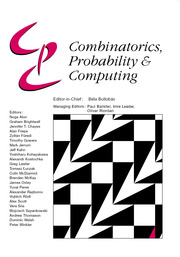Crossref Citations
This article has been cited by the following publications. This list is generated based on data provided by Crossref.
Dankelmann, Peter
Niessen, Thomas
and
Schiermeyer, Ingo
1994.
On Path-Tough Graphs.
SIAM Journal on Discrete Mathematics,
Vol. 7,
Issue. 4,
p.
571.
Brandt, Stephan
1997.
The Mathematics of Paul Erdös II.
Vol. 14,
Issue. ,
p.
32.
Brandt, Stephan
1997.
Graph-Theoretic Concepts in Computer Science.
Vol. 1335,
Issue. ,
p.
100.
Bauer, D.
Broersma, H.J.
Morgana, A.
and
Schmeichel, E.
2002.
Polynomial algorithms that prove an NP-Hard hypothesis implies an NP-hard conclusion.
Discrete Applied Mathematics,
Vol. 120,
Issue. 1-3,
p.
13.
Bauer, Douglas
Broersma, Hajo
and
Schmeichel, Edward
2006.
Toughness in Graphs – A Survey.
Graphs and Combinatorics,
Vol. 22,
Issue. 1,
p.
1.
Brandt, Stephan
2013.
The Mathematics of Paul Erdős II.
p.
81.
Jansen, Bart M. P.
Kozma, László
and
Nederlof, Jesper
2019.
Graph-Theoretic Concepts in Computer Science.
Vol. 11789,
Issue. ,
p.
27.
Büyükçolak, Yasemin
Gözüpek, Didem
Özkan, Sibel
and
Shalom, Mordechai
2019.
On one extension of Dirac’s theorem on Hamiltonicity.
Discrete Applied Mathematics,
Vol. 252,
Issue. ,
p.
10.

